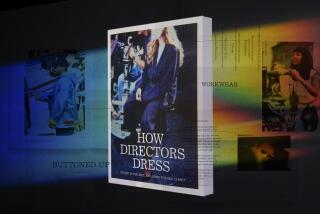Palos Verdes Peninsula pays tribute to a film industry ‘Renaissance man.’
- Share via
When Cecil B. DeMille made epic movies in yesterday’s Hollywood, the luxurious and exotic seemed to have no end.
Countless ostriches sacrificed their feathers to decorate the royal barge in the 1934 “Cleopatra.” In the title role, Claudette Colbert toyed with a real leopard, wore clinging, shimmering gowns with flowing trains, and sat on a marble throne with gigantic wings and lotus columns rising behind her.
When the movie was made, a young artist from New York named Ralph Jester had a hand in it, designing the throne set and working with two other designers to create the costumes.
It was his first film with the legendary director, and it began a 24-year association that saw Jester nominated for two Academy Awards for costume design. The first was for the 1956 classic, “The Ten Commandments,” which drew epic-sized audiences in a rerelease at the end of May of this year. The second came two years later for “The Buccaneer,” which was Jester’s last film with DeMille.
Between pictures, Jester lectured on filmmaking, taught at the USC film school and at the fledgling Palos Verdes College when it opened in the late 1940s. He wrote, sculpted and made documentary films, often on the expression of religion in architecture and sculpture. And he was an associate architect--with Lloyd Wright, son of Frank Lloyd Wright--on the landmark Wayfarers Chapel “glass church” in Portuguese Bend.
A longtime Palos Verdes Peninsula resident, Jester--who is 89 and in poor health--is being honored by the Palos Verdes Art Center with a showing of his Hollywood memorabilia in the Norris Film Gallery. The exhibit opens tonight with a reception at 8 p.m. It continues through Aug. 4.
Phil Lohmann, a member of the art center’s exhibition committee, called it a tribute to an accomplished community resident. “It’s high time it was done,” he said.
Edward Maeder, a Los Angeles County Museum of Art curator who organized the 1987 “Hollywood and History” film costume exhibit, calls Jester “a true Renaissance man” steeped in the history of art and architecture.
Although not a trained designer, Jester had a talent for creating costumes that mingled historical authenticity with the kind of Hollywood glamour the public expected on the screen, Maeder said,
“He was terribly modest about all this,” Maeder said. “He always said he never knew anything about costumes, but they needed somebody , and he had talent with a brush, and he just fell into it.”
The exhibit is dominated by renderings of costume and scenic designs, many of them from “Solomon and Sheba,” the last feature film Jester made. The 1959 picture not only captured drama on the screen, but produced drama on the set when Tyrone Power died during production. Yul Brynner replaced him.
Jester’s bust of Colbert as Cleopatra, along with still photos from the picture, greet visitors at the Norris gallery door. The show includes a sheaf of behind-the-scenes pictures showing Jester--as good-looking as a leading man--at work with DeMille and posing with Warren William, the “Cleopatra” Caesar, and Jester’s bust of him.
In conjunction with the show, the art center Film Society will screen “The Crusades,” a 1935 DeMille- Jester film, on June 29 at 7:30 p.m. in the Norris gallery. Leven Jester, a movie and video producer who assembled the exhibit, will discuss his father’s work. Admission is $5.
DeMille was famous for his monarchical temperament, and Leven Jester said his father often experienced it. They parted company a few times; sometimes Jester got fired, sometimes he quit. “My father stood up and said what he thought,” Jester said.
In an interview, Ralph Jester--calling DeMille a director who “knew what he wanted”--recalled a time that DeMille asked him a question, and he replied, “You never pay attention to anyone, I don’t know why you ask me.” DeMille ordered him off the set. But when they were working, the two had lunch together every day, and at night they watched the day’s filming at DeMille’s mansion.
Maeder called the Palos Verdes show “a wonderful tribute” to a man who is too little known, partly because of his own modesty. “He has always made light of his work, but he made an important contribution,” he said, adding that in the movie costume field where everyone thinks of Edith Head, it’s time to give credit to Ralph Jester.
More to Read
Only good movies
Get the Indie Focus newsletter, Mark Olsen's weekly guide to the world of cinema.
You may occasionally receive promotional content from the Los Angeles Times.










